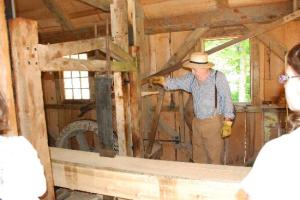It’s no secret that I love research. Of course, my husband may have a differing opinion, especially when supper is late because I’ve been “time traveling.” Since I write historical fiction, sometimes it’s not easy finding the details I need to make my story authentic. But that’s where the fun comes in.
For instance, do you know the sound made by a sawmill in 1838? I do. We tend to assume all sawmills have a giant circular blade that cuts through the wood. But those circular blades didn’t come into use until later in the 19th century. When I learned that the blade was long and vertical, and was propelled up and down, I had to know what my character heard as she neared the sawmill.  It took the better part of the afternoon—and yes, supper was late that day—but I hunted through websites and historical society resources until I found a video of an actual historic sawmill from the 1830s that has been restored and maintained. Oh, the wonderful whumpety-whumpety-whumpety-whump sound it made. I kept replaying the video, watching the men working the wood and listening to that magnificent sound. I closed my eyes and memorized it. I imagined myself in my character’s shoes, walking down the road, rounding the bend, and crossing the footbridge, listening to that sound as I drew closer.
It took the better part of the afternoon—and yes, supper was late that day—but I hunted through websites and historical society resources until I found a video of an actual historic sawmill from the 1830s that has been restored and maintained. Oh, the wonderful whumpety-whumpety-whumpety-whump sound it made. I kept replaying the video, watching the men working the wood and listening to that magnificent sound. I closed my eyes and memorized it. I imagined myself in my character’s shoes, walking down the road, rounding the bend, and crossing the footbridge, listening to that sound as I drew closer.
I became so sucked in to the scene that when a strange, foreign noise invaded my senses, I was startled, and wondered, “What in the world is that awful racket?” (The phone was ringing.)
I have traveled to a hot mineral springs and experienced soaking in the heavenly waters—in the name of research, of course. I’ve  tramped around a mountain meadow once inhabited by Cherokee Indians, and sat in the sweet grass and listened for their cries on the wind as they were forcibly removed from their land. I’ve strolled through museums and have run my fingers over a hand-made cradle, (How many babies were rocked in that wee bed?) and examined the way the craftsman assembled the cradle without a single nail.
tramped around a mountain meadow once inhabited by Cherokee Indians, and sat in the sweet grass and listened for their cries on the wind as they were forcibly removed from their land. I’ve strolled through museums and have run my fingers over a hand-made cradle, (How many babies were rocked in that wee bed?) and examined the way the craftsman assembled the cradle without a single nail.
I’ve wandered through old cemeteries and wept over the headstones that reflected such a short life for the one buried there. In one such cemetery, there was a row of headstones bearing the names of seven children, none of whom lived past their first birthday. Can you imagine the agony that poor mother felt laying her babies to rest?
 A couple of years ago, I traveled to the Texas hill country where I met with two of my writing buds, Eileen Key and Lynette Sowell. We toured the historic town of Fredericksburg and even stayed in one of the little dwellings that were dubbed “Sunday Houses.” Numerous tiny houses still line many of the streets there, and one became the setting for HOPE’S DWELLING PLACE, in Sundays In Fredericksburg.
A couple of years ago, I traveled to the Texas hill country where I met with two of my writing buds, Eileen Key and Lynette Sowell. We toured the historic town of Fredericksburg and even stayed in one of the little dwellings that were dubbed “Sunday Houses.” Numerous tiny houses still line many of the streets there, and one became the setting for HOPE’S DWELLING PLACE, in Sundays In Fredericksburg.
 Recently, I had the privilege of traveling to Fort Jackson, South Carolina and visiting the Chaplaincy School and Museum. Since the hero in my upcoming project was a chaplain during World War 1, I needed answers to several questions. I’ve found there isn’t nearly as much material available about WW1 as there is about WW2, but the gentleman I met at the Fort Jackson Chaplain Museum–historian and museum technician, Tim Taylor–was a wealth of information. I was grateful for the time he spent me, allowing me to pick his brain.
Recently, I had the privilege of traveling to Fort Jackson, South Carolina and visiting the Chaplaincy School and Museum. Since the hero in my upcoming project was a chaplain during World War 1, I needed answers to several questions. I’ve found there isn’t nearly as much material available about WW1 as there is about WW2, but the gentleman I met at the Fort Jackson Chaplain Museum–historian and museum technician, Tim Taylor–was a wealth of information. I was grateful for the time he spent me, allowing me to pick his brain.
While visiting the actual setting of one’s story is preferable in order to soak in the full flavor and surroundings, it’s not always possible. I visited the Chaplain Museum because the hero of my current book was an army chaplain during WW1. But I can’t go back in time and insert myself onto a battlefield to experience the sounds of the artillery and gunfire, the screams of the wounded, or the combined smell of gunpowder and blood that in all likelihood haunted the memory of those soldiers who survived. The only way I can recount the atrocities of war is through deep digging of the resources available and talking to those experts who have the knowledge to pass on.
Research—some writers hate it. Others, like me, get lost in it.





